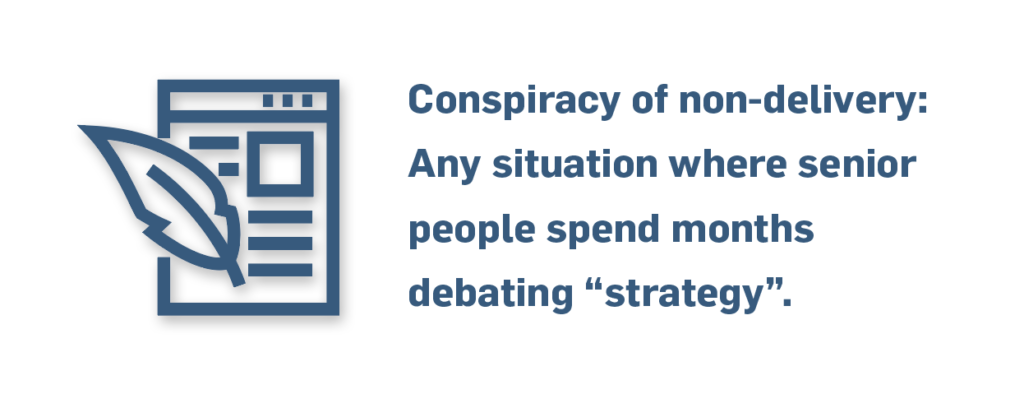This article is the fifth part of a 12-part series featuring snippets from my new book, The Agile Secret.
- 1. Living in the VUCA World
- 2. The Freelance Revolution
- 3. The Digital Revolution
- 4. The Birth of Agile
When we started Interactive Workshops, my buddy Andy and I settled on three maxims. Below are the benign, non-motivating, PG versions:
- Get it done.
- Don’t mess up.
- Say yes first, then work out how afterwards.
Built into the Agile Manifesto is a mechanism to make the customer pretty happy. If they get good-enough stuff early, and all the time, they are going to be pleased. Notice they haven’t got everything. It’s not perfect (unless perfect was part of the good-enough criteria). Imagine you go to a sandwich shop and they consistently make you a fully satisfying and delicious sandwich that is always ready just before you expect. Mmmm…
Are you wasting your time?
Back in the real world, a bunch of individuals are stuck in a frustrating meeting discussing for the third time some obscure point. They are not at all satisfied. They are not getting value from the meeting. Their project is late. They are, in fact, constantly frustrated. And half the attendees are from the supplier or vendor. Look around most cities and gaze through those glass windows – I’d estimate that about 50% of people feel they are wasting their time.
The Agile Manifesto calls us to sort out a few things:
- Deliver. No compromise. No excuses.
- Make valuable things
- Prioritise. (By implication, avoid distractions.)

I recently pressurised a multi-million dollar, top-selling European B2B sales exec into telling me the shortest possible working week he could do and still hit his figures. He said two days.
We have to know who our customer is. Freelancers know this. They have to send an invoice. For those of us in companies, it can be less clear but no less important. Who pays the bill? If our work is internal, who is our customer? What is valuable to them? Let’s prioritise that.
Instead of delivering valuable things, we could attempt the strategy of sucking-up to people. But in the end, whilst we may achieve our goal of staying safe, we just collude with a power structure of individuals each covering the arse of the other. Surely it’s better to get stuff done?
Yes is no, no is yes
What this level of focus requires, though, is some serious saying “no” skills. Saying “no” to pointless meetings, projects without a need, work that is less than inspiring. I trained for a while under a psychotherapist who often remarked, “Yes is no and no is yes.” Saying “no” to one thing creates the space to say “yes” to another.
We are also delivering something earlier than expectations. I love saying to clients that, “We can make it faster than you can decide to do it and review it.” I’m yet to be proved wrong. When designing a magazine or a short workshop, I can focus a team in a room, for a couple of days. With the right brief, this highly talented team of ten can get 20 days work done in two days, no sweat. Generally, our clients can’t handle a review timeline of less than a couple of weeks. Only one client in the history of Interactive Workshops has expressed concern that we might be able to work so quickly.

Some tips for getting it done
So what might that mean to the average knowledge worker in a global-service business? Here are some tips:
- Say “no” to everything possible that cannot be defined as a deliverable for a customer.
- Decide on a spec and a reasonable amount of effort for anything we are working on. E.g. a ten-slide deck with 30 words per page.
- Allocate to the task only the time we want to spend on it. In the case of the above, 45 minutes.
- Use a correct sequence. For our example, a technically correct sequence would be: define audience, define main message, sketch storyboard, type up, paste into PowerPoint template, add graphics, check and add builds.
- Set a tight deadline that is publicly committed to in calendars and to the client.
- Repeatedly beat the deadline.
My old mentor Jim used the expression “conspiracy of non-delivery” for any situation where senior people spent months debating “strategy” without coming up with the goods.
When we work in our organisation’s office, we don’t get out of bed, commute all that way, deal with the discomfort of hot desking, frazzle on the way home, to not get anything done. We came to deliver something valuable. To a client. As soon as possible. Let’s do it!
Part 6: Shipping Is The Metric
Download The Agile Secret on Amazon Kindle here.
